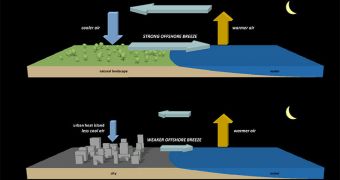The results of a new scientific investigation appear to indicate that pavements and a high degree of urbanization in general can facilitate the accumulation of pollutants above and within cities.
This is done by changing weather and local climate patterns by small, but significant margins, experts behind the new work say. The study, which was focused on the city of Houston, Texas, found that pollutants accumulate rather than be carried off to the sea.
The correlation was especially strong during warm summer days, the team discovered. The international research effort that conducted the work was led by scientists at the US National Center for Atmospheric Research (NCAR).
Directly concerned by these results are authorities governing over fast-growing coastal cities in the United States and other mid-latitude regions overseas. These areas may be at risk of developing the same type of summer climate patterns that affect Houston.
Smog and other pollution are usually cleared out by gentle breezes sweeping through the city. However, when all surfaces are paved, and strip malls and subdivisions are built all over the place, these breezes stop blowing.
This means that the pollutants remain at the locations where they are produced, rather than being taken out into the ocean, where they can neutralized. In order to conduct the new study, experts combined atmospheric measurements with computer simulations, to get the best possible results.
One of the most interesting results was the fact that the standard different between land and sea temperatures is reduced severely during the summer, mostly due to the fact that pavement can store tremendous amounts of heat for the entire night.
By the time it cools, morning comes again, and the barely-lost heat accumulates again. This phenomenon lasts for the entire summer. “The developed area of Houston has a major impact on local air pollution,” NCAR scientist Fei Chen explains.
“If the city continues to expand, it's going to make the winds even weaker in the summertime, and that will make air pollution much worse,” adds the expert, the lead author of the new investigation.
The US Air Force (USAF) Weather Agency, the US Defense Threat Reduction Agency, and the National Science Foundation (NSF) provided the funding needed for this work. Details of the study will appear in this month's issue of the esteemed Journal of Geophysical Research.

 14 DAY TRIAL //
14 DAY TRIAL //